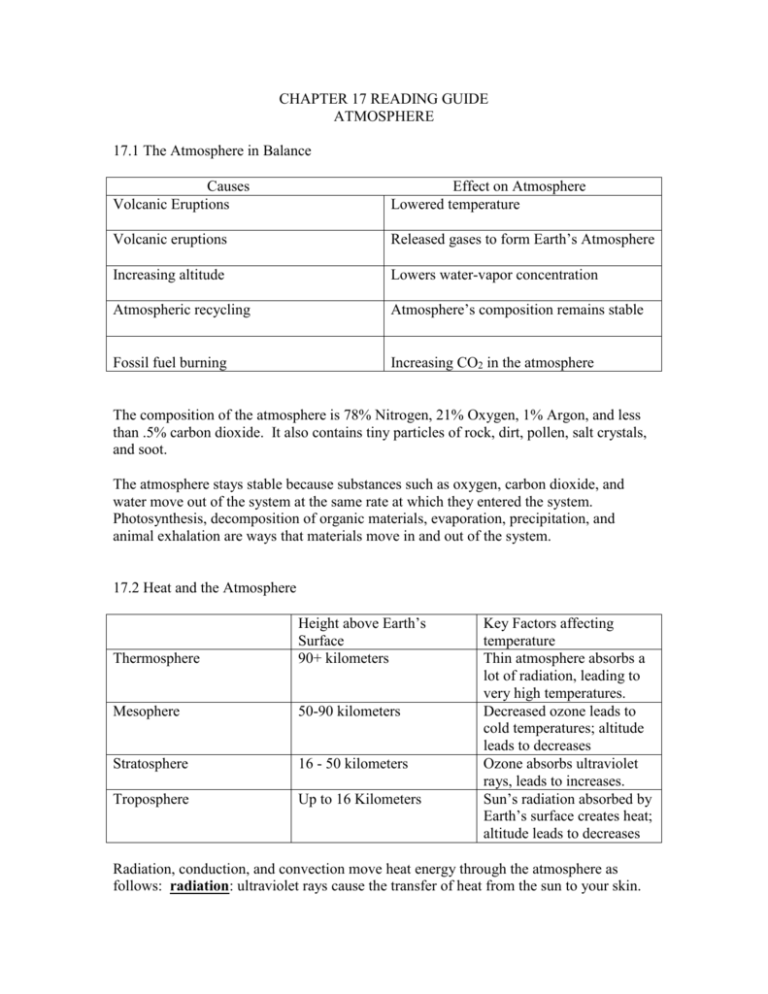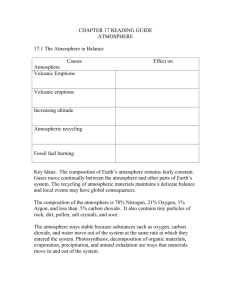CHAPTER 17 READING GUIDE
advertisement

CHAPTER 17 READING GUIDE ATMOSPHERE 17.1 The Atmosphere in Balance Causes Volcanic Eruptions Effect on Atmosphere Lowered temperature Volcanic eruptions Released gases to form Earth’s Atmosphere Increasing altitude Lowers water-vapor concentration Atmospheric recycling Atmosphere’s composition remains stable Fossil fuel burning Increasing CO2 in the atmosphere The composition of the atmosphere is 78% Nitrogen, 21% Oxygen, 1% Argon, and less than .5% carbon dioxide. It also contains tiny particles of rock, dirt, pollen, salt crystals, and soot. The atmosphere stays stable because substances such as oxygen, carbon dioxide, and water move out of the system at the same rate at which they entered the system. Photosynthesis, decomposition of organic materials, evaporation, precipitation, and animal exhalation are ways that materials move in and out of the system. 17.2 Heat and the Atmosphere Thermosphere Height above Earth’s Surface 90+ kilometers Mesophere 50-90 kilometers Stratosphere 16 - 50 kilometers Troposphere Up to 16 Kilometers Key Factors affecting temperature Thin atmosphere absorbs a lot of radiation, leading to very high temperatures. Decreased ozone leads to cold temperatures; altitude leads to decreases Ozone absorbs ultraviolet rays, leads to increases. Sun’s radiation absorbed by Earth’s surface creates heat; altitude leads to decreases Radiation, conduction, and convection move heat energy through the atmosphere as follows: radiation: ultraviolet rays cause the transfer of heat from the sun to your skin. conduction: a fire’s warmth spreading to your body comes from conduction of heat from the fire to the air and then from the air to your body. convection: when a building’s upper floors are hotter than the lower ones, convection had made the hot air raise and cool air fall. 3. Explain why it is important to keep the Earth’s heat budget balanced. Tell how greenhouse effect helps maintain this balance: When Earth’s heat budget is balanced, its temperature remains relatively constant. If the budget becomes unbalanced, Earth’s average temperatures would rise or fall depending on the direction of the imbalance. The greenhouse effect captures solar radiation that would otherwise disperse back into space. 17.3 Local Temperature Variations 1. 2. 3. 4. Factors Affecting Temperature at Given Location Intensity of Insolation Type of Surface Time of Day 1. Land Time of Year 2. Water Latitude Cloud cover 2. Explain how one of the factors you listed in the organizer above affects the temperature at a given location. Time of Day: affects the angle of the sun’s rays, with the most direct rays falling at noon and building heat into the afternoon. Latitude: affects the angle of the sun’s rays by placing some parts of Earth closer to the sun than others. Time of Year: affects how close Earth is to the sun, again affecting the angle of the sun’s rays. Cloud cover reflects insolation back into space, decreasing the temperature on Earth. Land: Land heats up faster and cools down faster than water, which allows for high temps during the day and cooler temps at night, as well as temp fluctuations from day to day. Water: Water takes longer to heat up and cool down. Water temperature does not vary at a fast rate of time. 17.4 Human Impact on the Atmosphere Air Pollution Acid Rain Global Warming Smog 1. Can cause 1. unstable 1. health and severe problems. weather 2. Destruction of and 2. monuments temperature and other items . 2. melting of the polar ice cap resulting in rising sea levels. 3. Crop problems. Health problems/illne sses reduced crop yields on farms. Ozone Depletion 1. Health problems/illne sses 2. death of marine life. 3. Crop problems.








